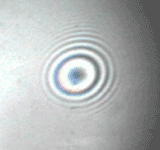The scanned image may suffer the intrusive appearance of Newton Rings that ruin the scan. To properly deal with the problem we need
to understand why this happens and what we can do to eliminate the problem. The image at top right shows a Newton Ring pattern,
showing the dark and light patterns typical of Newton Rings.
|
|
Scanners Susceptible to
Newton Rings
|
|
In Flatbed scanning users who try placing the dry film directly on the glass get Newton Rings.
In Film scanning, users who use the glass holder also get Newton Rings.
|
|
|
In optics, a series of concentric light- and dark-coloured bands observed when two reflective surfaces are is placed or exist at a
slight angle to the other. The phenomenon is caused by the interference of the reflecting light waves from each surface, i.e, the
superimposing of trains of the two waves, so that when their crests are in phase (coincide), the light brightens, and when the
trough and crest are completely out of phase, they cancel out.
When film is one of the reflective surfaces and glass is the other, any unevenness or curl of the film will cause the interactive
reflections or Newton Rings. The light waves reflected by the film interact with the reflections from the glass. The interference
patterns that this interactive reflections generate are known as Newton rings named after the English 17th-century scientist Sir
Isaac Newton who discovered their cause and explained them.
|
|
Where do Newton Rings
Occur in Photography
|
|
- In scanning, when film is placed near or against glass as when dry film is placed on a holder whose elevation is
only about 1 mm, the film may curve down and come within the distance at which the reflections that cause
Newton Rings are generated.
- Newton rings are encountered in old fashioned devices such as the glass holder for the NIKON and a diffuser device that was
sold to Minolta scanner users. These devices were used in a futile attempt to flatten the film.
|
|
Web Misinformation about
Newton Rings
|
|
- Quote from one Web Site: “When scanning, the old darkroom enemies, Newton's rings, are waiting for a chance to show their
face. Especially when using (The author’s proprietary product) there is a bigger chance that you will see them, because the tiny
little colored rings can no longer be hidden in the rough grain structure that is now past. So they should be banned from the
beginning. Etc.
The author attributes the existence of Newton Rings to the fact that his product flushed them out. The mischievous little rings
had been hiding there all the time inside the grain and if had not been for this gadget, the Newton rings would have probably
laid there within the grain and not bothered any one. The proper technical explanation is that the gadget was itself to blame: it
introduced a reflective surface whose reflections interacted with the film’s causing the interference waves and Newton Rings.
|
|
Will a Glass Holder
generate Newton
Rings, Flatten film?
|
|
- Yes, unless the glass is AN glass. Flatten film? Not really. Trying to overcome film curl by using a glass holder is no
guarantee that the film will be flat. The portion of the film that will be flat is that portion that curves against the glass.
|
Should you use
Anti-Newton glass for your
film scanner Glass Holder?
|
|
- AN glass has a microscopically rough surface, and the microscopic corrugations are not visible to the naked eye but do impair
the image nonetheless. AN glass works because the corrugations disrupt or break up the interference waves that cause
Newton rings. AN glass therefore is not the same as perfectly clear glass. if it were placed in front of the lens it would blur the
image. It does just that when placed on a scanner. No, you should not use a glass holder, with or without AN glass.
|
|
|
Interestingly, Newton rings have technical applications.
The phenomena is often used in testing the uniformity of a polished surface by studying the interference pattern the curved
surface makes when placed in contact with a perfectly flat glass surface. The formation of Newton Rings shows that the surface
tested is not flat, and the metrics of the rings are a measure of the un-flatness.
|
|









